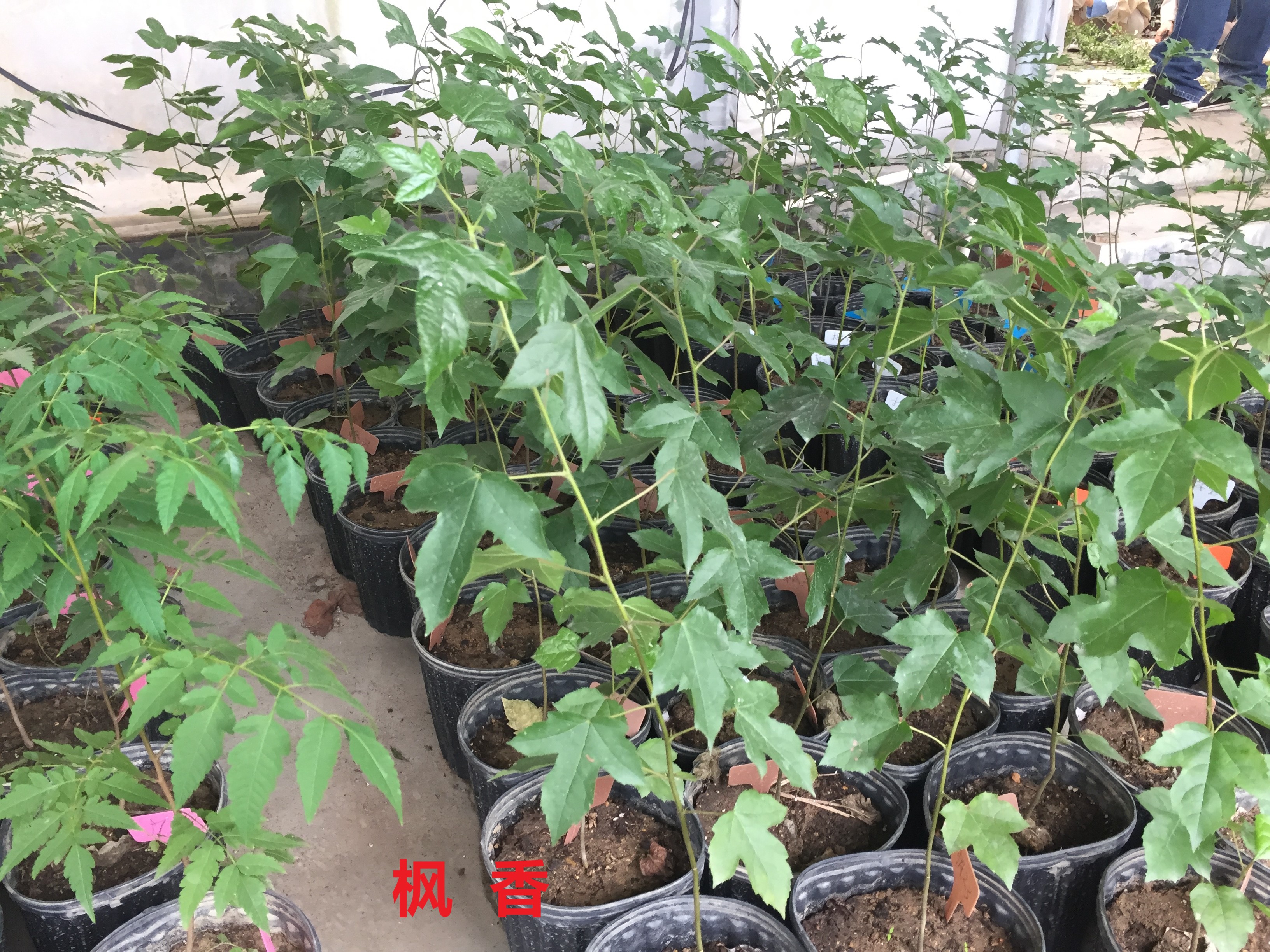 PDF(1439 KB)
PDF(1439 KB)


Resistance response of five afforestation tree species under drought stress
HONG Zhen, LIU Shuxin, HONG Conghao, LEI Xiaohua
Journal of Nanjing Forestry University (Natural Sciences Edition) ›› 2021, Vol. 45 ›› Issue (2) : 111-119.
 PDF(1439 KB)
PDF(1439 KB)
 PDF(1439 KB)
PDF(1439 KB)
Resistance response of five afforestation tree species under drought stress
 ,
,
【Objective】To select species for afforestation in difficult sites by evaluating the drought resistance of five native and alien tree species. 【Methods】Pot experiments were conducted to study the physiological response and drought resistance of 1-year-old seedlings of Liquidambar formosana, Pistacia chinensis, Ulmus elongata, Koelreuteria bipinnata, and Quercus texana under conditions of appropriate humidity and light, moderate, and severe drought (75%-80%, 55%-60%, 40%-45% and 30%-35% of the soil field capacity).【Result】With the increase of drought extent, five species showed different levels of symptoms of drought stress and major symptoms are yellow leaves and wilting. Severely affected branches’ tops dried up with the increasing time of continuing drought. After sereve drought stress for 30 days, partial seedings of U. elongata and K. bipinnata died, whole leaves of P. chinensis turned yellow or red, and leaves in the middle and lower portions of L. formosana and Q. texana turned yellow and dry. The chlorophyll and relative water content in the leaves of the five tree species decreased; the relative conductance and malondialdehyde (MDA) concentration in leaves increased; the content of free proline, soluble sugar and protein in leaves increased. The SOD, POD, and CAT activities in the leaves of Q. texana increased, whereas it increased and then decreased in L. formosana, P. chinensis, and K. bipinnata trees. With the increasing drought extent, the SOD and CAT activities in the leaves of U. elongate increased at first and then decreased, while the activity of POD increased with the increasing drought stress. Membership function analysis showed that under moderate and severe drought stress, drought resistance levels were Q. texana > L. formosana > P. chinensis > U. elongate > K. bipinnata.【Conclusion】Q. texana has the strongest drought resistance among the five tree species, which provides a competitive advantage for afforestation usage in difficult sites.

afforestation tree species / drought stress / physiological responses / evaluation of drought resistance / subordinate function method
| [1] |
洪震, 练发良, 刘术新, 等. 3 种乡土园林地被植物对干旱胁迫的生理响应[J]. 浙江农林大学学报, 2016,33(4):636-642.
|
| [2] |
何小三, 徐林初, 龚春, 等. 干旱胁迫对‘赣无 12’苗期光合特性的影响[J]. 中南林业科技大学学报, 2018,38(12):52-61.
|
| [3] |
邓辉茗, 龙聪颖, 蔡仕珍, 等. 不同水分胁迫对绵毛水苏幼苗形态和生理特性的影响[J]. 西北植物学报, 2018,38(6):1099-1108.
|
| [4] |
郑鹏丽, 黄晓蓉, 费永俊, 等. 水分胁迫对桢楠幼树光合生理特性的影响[J]. 中南林业科技大学学报, 2019,39(10):64-70.
|
| [5] |
|
| [6] |
|
| [7] |
刘盼盼, 许冲勇, 孙红梅, 等. 枫香优良无性系组织培养研究[J]. 林业与环境科学, 2019,35(2):14-19.
|
| [8] |
庞宏东, 胡兴宜, 胡文杰, 等. 淹水胁迫对枫杨等 3 个树种生理生化特性的影响[J]. 中南林业科技大学学报, 2018,38(10):15-20,26.
|
| [9] |
胡文杰, 庞宏东, 胡兴宜, 等. 9 年生枫香种源变异及优良种源选择[J]. 中南林业科技大学学报, 2019,39(3):40-46.
|
| [10] |
郭欢欢, 刘勇, 姚飞, 等. 黄连木苗期年生长节律、生物量分配及养分积累[J]. 中南林业科技大学学报, 2018,38(7):71-75.
|
| [11] |
丁锡珍. 彩叶树种娜塔栎的繁育与栽培技术[J]. 现代园艺, 2017(16):38.
|
| [12] |
李峰卿, 王秀花, 楚秀丽, 等. 缓释肥 N/P 比及加载量对浙江楠等 5 种珍贵树种 1 年生容器苗生长和养分库构建的影响[J]. 南京林业大学学报(自然科学版), 2020,44(1):72-80.
|
| [13] |
罗喻才, 陈琳, 彭巧华, 等. 我国极小种群野生植物长序榆(Ulmus elongate)的分布格局和群落调查[J]. 南方林业科学, 2018,46(1):1-4.
|
| [14] |
陈琳, 余泽平, 聂堂杰, 等. 江西官山8种珍贵野生植物资源及保护策略[J]. 中国野生植物资源, 2018,37(6):63-67.
|
| [15] |
黄利斌, 梁珍海, 窦全琴, 等. 观赏栾树新品种‘金焰彩栾’[J]. 林业科学, 2015,51(5):165.
|
| [16] |
吕运舟, 董筱昀, 黄利斌. 黄山栾树实时荧光定量 PCR 内参基因的筛选[J]. 分子植物育种, 2019,17(2):553-560.
|
| [17] |
洪震, 刘术新, 练发良, 等. 4 个小叶蚊母树无性系幼苗在不同土壤类型上的生长差异[J]. 浙江农林大学学报, 2018,35(2):380-386.
|
| [18] |
李玲. 植物生理学模块实验指导[M]. 北京: 科学出版社, 2009.
|
| [19] |
娄晓瑞. 干旱胁迫对 10 种不同种源地墨西哥柏的影响[D]. 南京: 南京林业大学, 2012.
|
| [20] |
刘菲, 周隆腾, 蒋燚, 等. 不同种源江南油杉幼苗对干旱胁迫的生理响应[J]. 中南林业科技大学学报, 2018,38(11):35-45.
|
| [21] |
赵琳, 郎南军, 温绍龙, 等. 云南干热河谷4种植物抗旱机理的研究[J]. 西部林业科学, 2006,35(2):9-16.
|
| [22] |
蒋志荣, 杨占彪, 汪君, 等. 兰州九州台四种绿化树种抗旱性机理比较研究[J]. 中国沙漠, 2006,26(4):553-558.
|
| [23] |
马书尚, 杨淑慎. 不良环境对植物细胞膜的伤害[J]. 植物生理学实验技术, 2000,1(1):199-201.
|
| [24] |
张海燕, 李贵全. 大豆抗旱性与生理生态指标关系的研究[J]. 中国农学通报, 2005,21(8):140-142.
|
| [25] |
王爱国, 邵从本, 罗广华, 等. 丙二醛作为植物脂质过氧化指标的探讨[J]. 植物生理学通讯, 1986,22(2):55-57.
|
| [26] |
|
| [27] |
王宇超, 王得祥, 彭少兵, 等. 干旱胁迫对木本滨藜生理特性的影响[J]. 林业科学, 2010,46(1):61-67.
|
| [28] |
文瑛, 廖飞勇, 刘智慧. 不同水分胁迫对黄枝槐生理特性的影响研究[J]. 中国农学通报, 2012,28(13):47-52.
|
| [29] |
刘锦春, 钟章成, 何跃军. 干旱胁迫及复水对喀斯特地区柏木幼苗活性氧清除系统的影响[J]. 应用生态学报, 2011,22(11):2836-2840.
|
| [30] |
任文伟, 钱吉, 马骏, 等. 不同地理种群羊草在聚乙二醇胁迫下含水量和游离脯氨酸含量的比较[J]. 生态学报, 2000,20(2):349-352.
|
| [31] |
|
| [32] |
罗杰, 周光良, 胡庭兴, 等. 干旱胁迫对润楠幼苗生长和生理生化指标的影响[J]. 应用与环境生物学报, 2015,21(3):563-570.
|
| [33] |
姜英淑, 陈书明, 王秋玉, 等. 干旱胁迫对 2 个欧李种源生理特征的影响[J]. 林业科学, 2009,45(6):6-10.
|
| [34] |
刘方春, 邢尚军, 马海林, 等. 干旱对侧柏容器苗和裸根苗生长、营养及生理特性的影响[J]. 北京林业大学学报, 2014,36(5):68-73.
|
| [35] |
崔婷茹, 于慧敏, 李会彬, 等. 干旱胁迫及复水对狼尾草幼苗生理特性的影响[J]. 草业科学, 2017,34(4):788-793.
|
| [36] |
冯晓敏, 张永清. 水分胁迫下不同耐旱性糜子叶片保护酶活性及膜脂过氧化特性[J]. 干旱地区农业研究, 2019,37(1):200-207.
|
| [37] |
刘遵春, 包东娥. 水分胁迫对金光杏梅幼苗生长及其生理指标的影响[J]. 河北农业大学学报, 2007,30(5):28-31, 88.
|
| [38] |
赵兰, 邢新婷, 聂庆娟, 等. 4种地被观赏竹抗旱性综合评价研究[J]. 西北林学院学报, 2011,26(1):18-21.
|
/
| 〈 |
|
〉 |